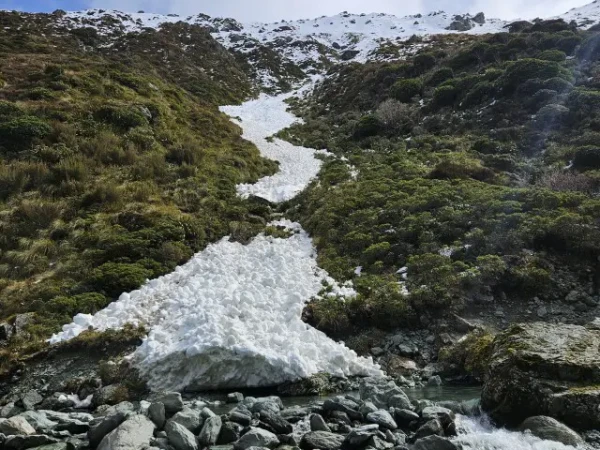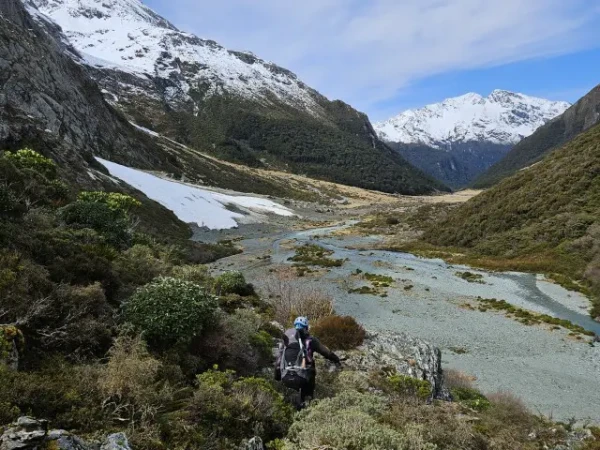Spring Avalanche Safety for Trampers
Planning a tramp or hike in the mountains this spring? Avalanche safety needs to be top of mind.
With storms still bringing new dumps of snow in alpine environments, the avalanche danger will continue in spring – and even into early summer. Rapidly increasing temperatures and rain can produce avalanches that reach the valley floor, so when it comes to avalanche safety, trampers need to be extra vigilant in spring and beyond.
Unsure about where to start? NZ Mountain Safety Council (MSC) has put together some useful avalanche safety pointers to help keep you safe in the outdoors.
Be aware of valley floor avalanches
A warming snowpack due to milder temperatures and rain (rather than snow) can cause large avalanches that run further down the mountain, sometimes even bigger than those seen in winter. That means if you're walking through valleys, gullies or stream beds this spring, you could be exposed to avalanches.
An easy way to decrease your exposure to these potentially destructive avalanches is to follow these simple guidelines:
- Start early: Spring sun can rapidly warm snow, increasing avalanche danger in the afternoon. Start your hike early and aim to be well clear of steep, snowy terrain before the heat of the day.
- Delay your trip after a storm: During and directly after a storm, the snowpack can become unstable and prone to wet snow avalanches. Wait for 24-48 hours before heading out, to allow the snow to settle and any natural avalanches to occur.
- Avoid travel below steep slopes: Even if you’re on the valley floor, there’s a chance avalanches from steep terrain can reach you there. Avoid stopping in gullies, small side streams, under cliff bands or in clearings below steep slopes. The same goes for where you set up camp and pitch your tent.
Check the avalanche forecast
The NZ Avalanche Advisory (NZAA), which is owned and operated by MSC, provides avalanche forecasts for 13 backcountry alpine regions across the country. Check avalanche.net.nz for the latest avalanche forecast, follow the advice and adjust your plans accordingly.
No avalanche forecast for the area? Check for the closest regional forecast. This will have information that’s still useful to consider, such as the avalanche problems in the area, possible freezing level and sliding danger.
Even when avalanche forecasting has finished for the season, it is likely that some snow will still be around. Talk to the local Department of Conservation (DOC) visitor centre for up-to-date information on the latest conditions.
Check if your route enters avalanche terrain
If you’re heading into an alpine environment (meaning it is above or very near the bushline) and there is snow on the ground, then you may be heading into avalanche terrain. You’ll need to check travel advice and the avalanche danger from the avalanche advisory or DOC. This goes for spring as well as winter.
Not sure if you’re heading into avalanche terrain? Here are five easy prompts to help you figure it out.
- Terrain: Is your route in an alpine environment? Check a topographical map to identify if it’s going close to or above the bushline.
- Snow: Does the route go through snow or directly below it? The snow level will fluctuate throughout the year, so check the current snowline to see if it will impact your route.
- Angle: If there is snow on the ground or directly above your route, look at the angle of the slope. For a slope to pose an avalanche danger, the angle at the start zone needs to be 15 degrees or above.
- Plan My Walk: Use Plan My Walk to help you understand possible dangers. If the track is covered by the avalanche advisory and is within avalanche terrain, Plan My Walk will display the avalanche danger rating as a track alert.
- Ask: If you’re unsure, check in with the local DOC visitor centre for track-specific advice.
Get avalanche training and equipment
It may seem over the top to have avalanche training and equipment for a 1-day tramp, but if you’re travelling in avalanche terrain in winter, spring or early summer, basic avalanche training is vital, especially in the Southern Alps, central North Island or Mt Taranaki.
MSC offers a free online course for understanding avalanches, which is a good starting point. Follow this up with a hands-on avalanche skills course. Some providers offer courses specifically for trampers. See a full list of providers here.
For the latest updates on avalanches, follow NZAA Instagram and Facebook.
Enjoy your outdoor adventuring and keep safe this spring!
PHOTO CREDIT: James Watson | NZAA Public Observation.

